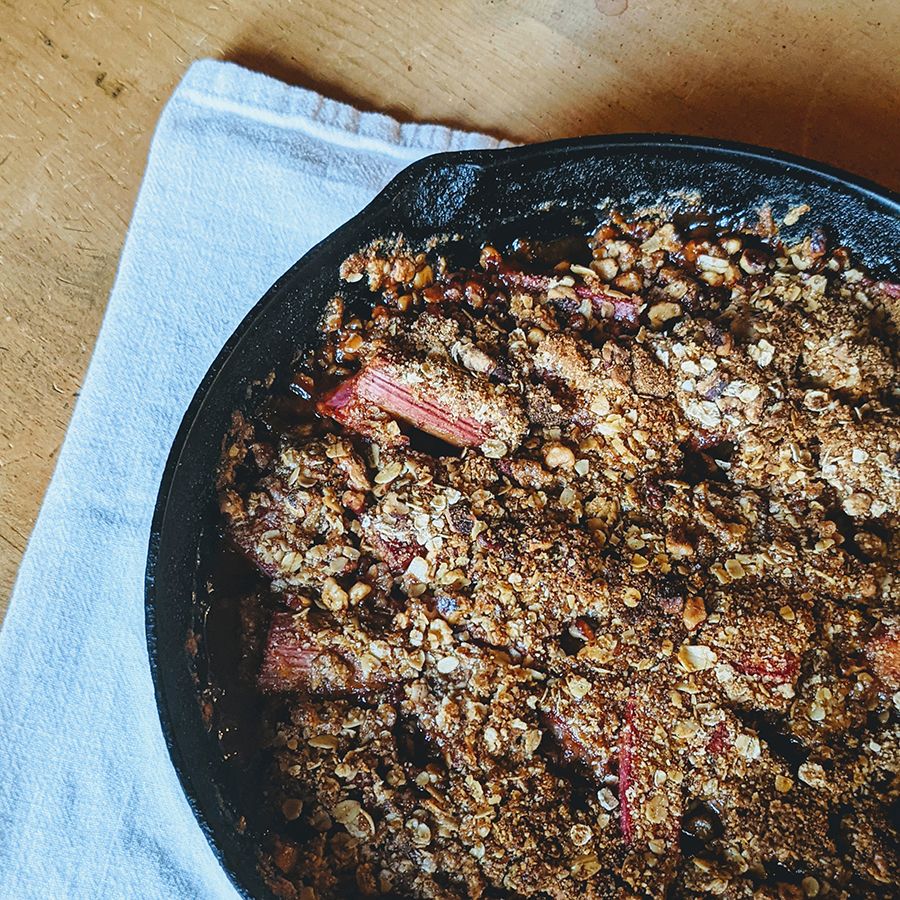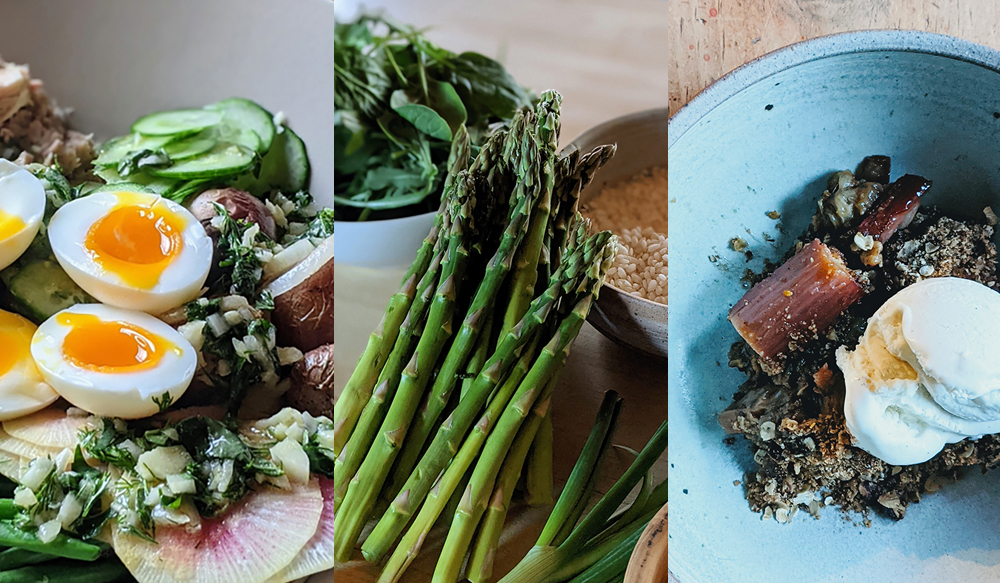
Three Recipes to Celebrate Spring in the Southwest
Spring in the Southwest is full of gorgeous blossoms, warm afternoons, and gusty winds. Even though most of my time now involves running Stokli and increasing access to incredible dry goods made across the Southwest with my co-founder Hans, for most of my career I’ve been cooking in restaurants, developing recipes, or writing about food. I’m so happy to share three of my all-time favorite spring recipes with a Southwest kick. I hope they bring you and yours a bit of magic around the table as we head into Spring.
If you’re new around here, welcome! Stokli is a membership based online general store filled with Southwest pantry staples, specialty foods, bath, beauty and home goods. Because of our members, small producers keep 100% the price for their products which is the heart & soul of what we are all about— making it easy to access dry goods from the comfort of home, and with every purchase, our members actively participate in shifting economic power to small producers (If you live in Santa Fe we deliver, for everyone else we ship).
Want to find out more? Start here. Ready to get cooking? Keep reading for Spring recipes made for celebrating.
Salade Niçoise
Time: 1 hour
Yield: Serves 4-6
Sometime towards the end of the 19th century, Salade Niçoise started popping up on restaurant menus along the blue coast of Nice in southern France. The core ingredients have stayed the same— tuna or anchovies, potatoes, vegetables, a bright and herby dressing, but a host of variations have evolved over the years. This hearty salad is not only a full meal, it also makes wonderful leftovers. I would even go so far as to say the next day might be even more delicious than the day before because even though it might not look as pretty, all of the tuna and vegetables have had the night to soak up the vinaigrette.
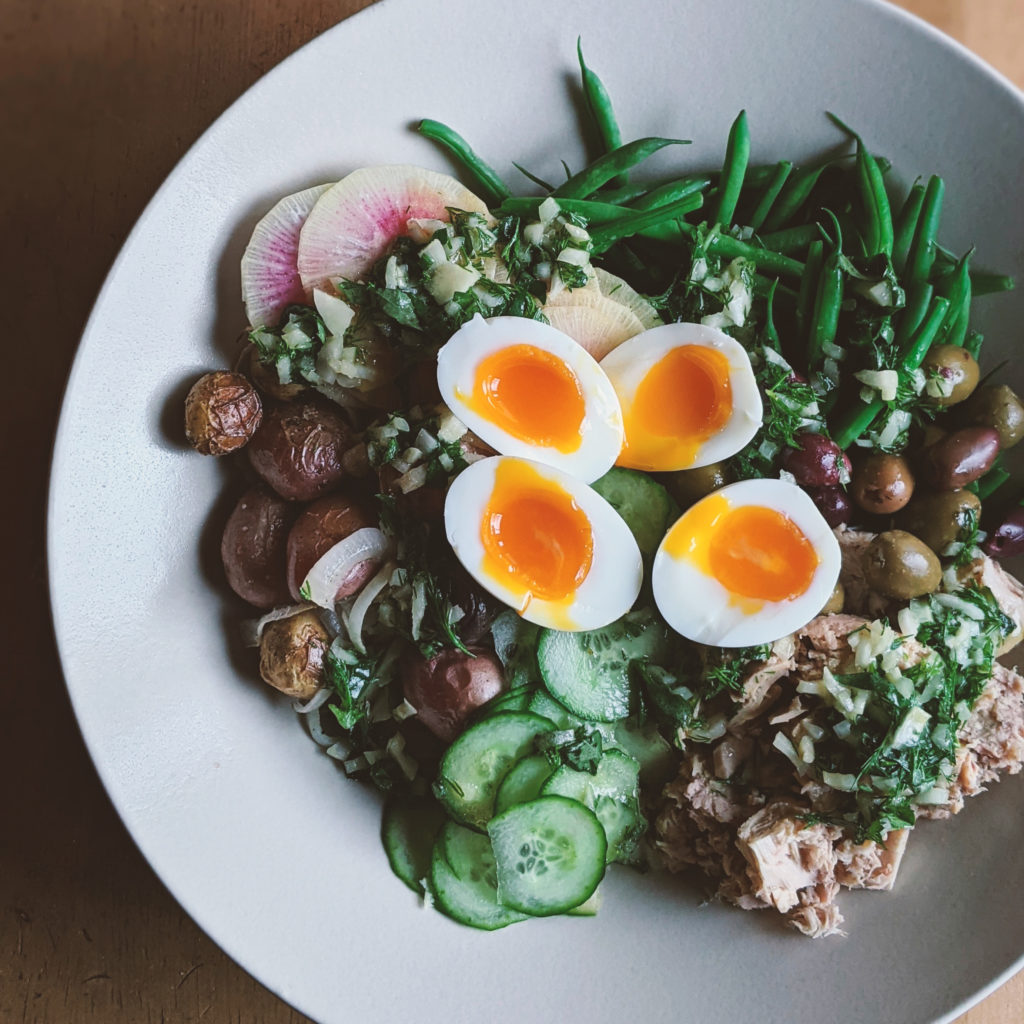
This is also a salad that can easily pivot depending on the time of year. In the summer when tomatoes are at their peak, it would be a shame to leave them out. Some might argue that tomatoes should always be included, but since it’s early spring, I swapped out the tomatoes for sliced radish and never looked back.
This recipe calls for three soft-boiled eggs. If serving six people, this would allow everyone to have one half. If you want more eggs, cook more! Also if you want to make the whole salad but are only serving two people at a time, just cook enough eggs for the number of people you are serving. The next day before enjoying leftovers, cook a couple more eggs.
Let’s talk real quick about the vegetables. The vegetables in this salad are meant to be tender, but you can easily find substitutions. For example, “new potatoes” are found at farmers markets more than many shops because their skins are thin and their sugars have not yet converted to starch so they are extra tender and sweet. Haricot verts are younger, longer, and skinnier than regular green beans and are more tender. If you can’t find haricot verts, no worries, just blanch regular green beans and once they are cool enough to handle, cut or split them in half lengthwise.
Instead of boiling potatoes, I like to roast them with slices of onion, a drizzle of olive oil, and High Desert Herbs. These little crispy beauties are the reason I make jammy eggs to go on top. Just dip a crispy potato in the soft custardy egg yolk and you’ll know exactly what I mean.
Ingredients
1 lb. small or new potatoes
1 medium onion (red or yellow), sliced
1 T. olive oil
2 t. High Desert Herbs
½ lb. Haricot Verts or green beans
3 eggs
½-1 seedless cucumber depending on size, thinly sliced
1-3 Radishes, depending on size, thinly sliced
1 c. pitted mixed olives, drained
3, 5 oz. cans, wild-harvested albacore tuna packed in oil
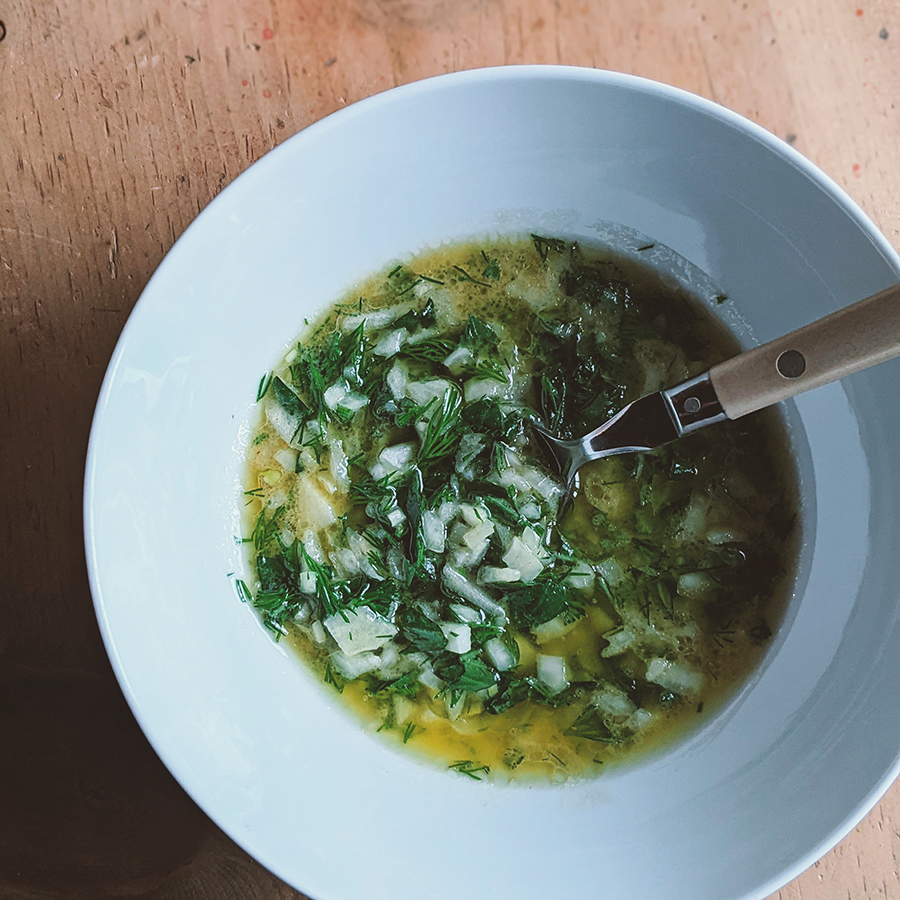
For the vinaigrette:
¼ c. extra virgin olive oil
¼ c.freshly squeezed lemon juice, seeds discarded
2 t. dijon mustard
1 T. fresh dill, roughly chopped
1 T. fresh basil, roughly chopped
1 t. honey
1 shallot, finely chopped
1 clove garlic, finely chopped
Salt and pepper
Method
Preheat the oven to 425 f. Line a sheet tray with parchment paper or foil and gently toss the whole potatoes, sliced onions, olive oil, dried herbs, salt, and pepper together on the sheet tray. Roast for 30 minutes, or until the potatoes are tender when pierced with the tip of a knife. Reserve.
Fill a medium saucepan ¾ full of water and bring to a boil. Season with salt until the water tastes like the sea. Before you blanch the beans, prepare a bowl of ice water. Drop the beans in the boiling water and cook just until they are tender around 3 minutes. Using tongs, transfer the beans to the ice water to stop the cooking. Transfer the beans to a clean kitchen towel and reserve.
In this same pot of boiling water, gently drop the eggs into the boiling water and gently simmer for 7 minutes. Transfer the eggs to the leftover ice water bath until cool enough to handle. Peel the eggs and reserve.
Make the vinaigrette: In a small bowl whisk together the olive oil, lemon juice, mustard, dill, basil, honey, shallot, garlic, salt, and pepper.
Prepare the salad for serving: On a large platter, arrange the potatoes, green beans, cucumber, radish, olives, and tuna. Spoon the vinaigrette generously over the vegetables and tuna. Slice eggs in half and arrange on top. Serve immediately.
Spring Vegetable Risotto
Time: 30 mins
Yield: Serves 6
This is how the pros make risotto in your favorite restaurant. I know this because, in addition to being Italian, I used to be one of them. This is a dish that for some wonderful reason, always feels special. It only takes about 20 minutes to make once you get cooking, which is not any longer than most pasta. It’s an incredible side, but more than enough for a meal on its own. The key to making risotto is gathering all your ingredients in advance before you start, having them measured out, ready to go in bowls. I know, it’s going to feel like you’re on a cooking show, but it just makes everything easier. Once you start, you don’t want to step away.
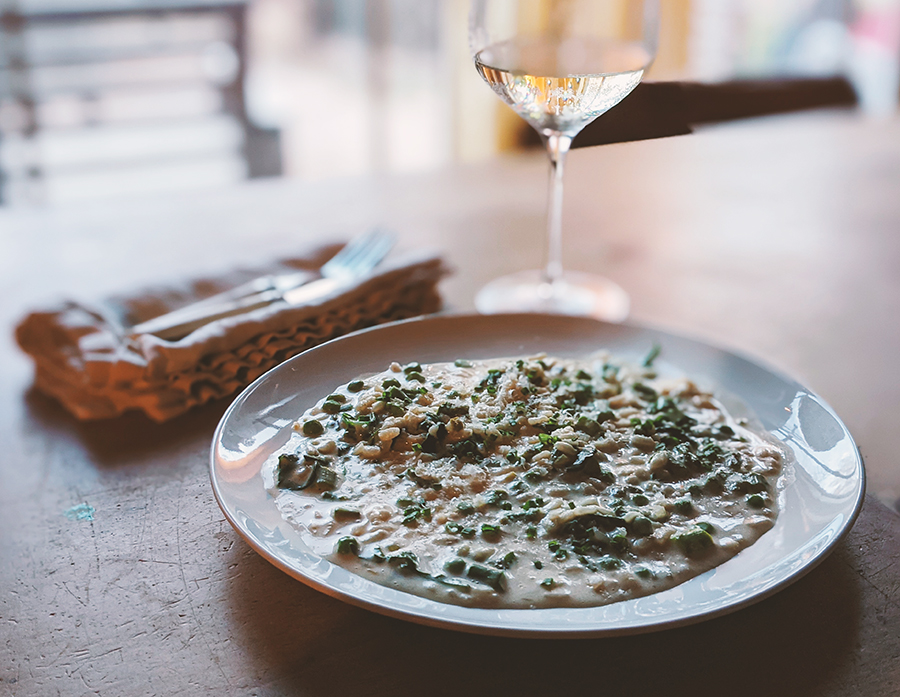
Over the years, I have worked with incredible Chefs who taught me their favorite ways to make this dish shine. And, like many things, the beauty lies in its simplicity. You can use red wine or no wine, pretty much any vegetable, a variety of broths, you could even add meat or fish. You can come up with all kinds of flavor combinations, but I have discovered most of the risottos that have stopped me in my tracks and embedded themselves into my memory are the ones that highlight a few complimentary ingredients—beets and horseradish in early summer, wild mushrooms and caramelized onions in fall, red wine & braised short ribs in winter, and the one I share with you today, Spring Vegetable Risotto that celebrates the glorious green shoots that are just starting to pop out of the ground.
This is probably one of the easiest and most delightful dishes to make for a dinner party. You can cook the rice until it’s just undercooked and spread it in a thin layer on a sheet tray to cool, then keep refrigerated until you are ready to serve. When you are ready, just reheat it on the stove with hot broth until it finishes cooking and add your other finishing ingredients. Leftover risotto served with a poached or fried egg makes a delightful breakfast too.
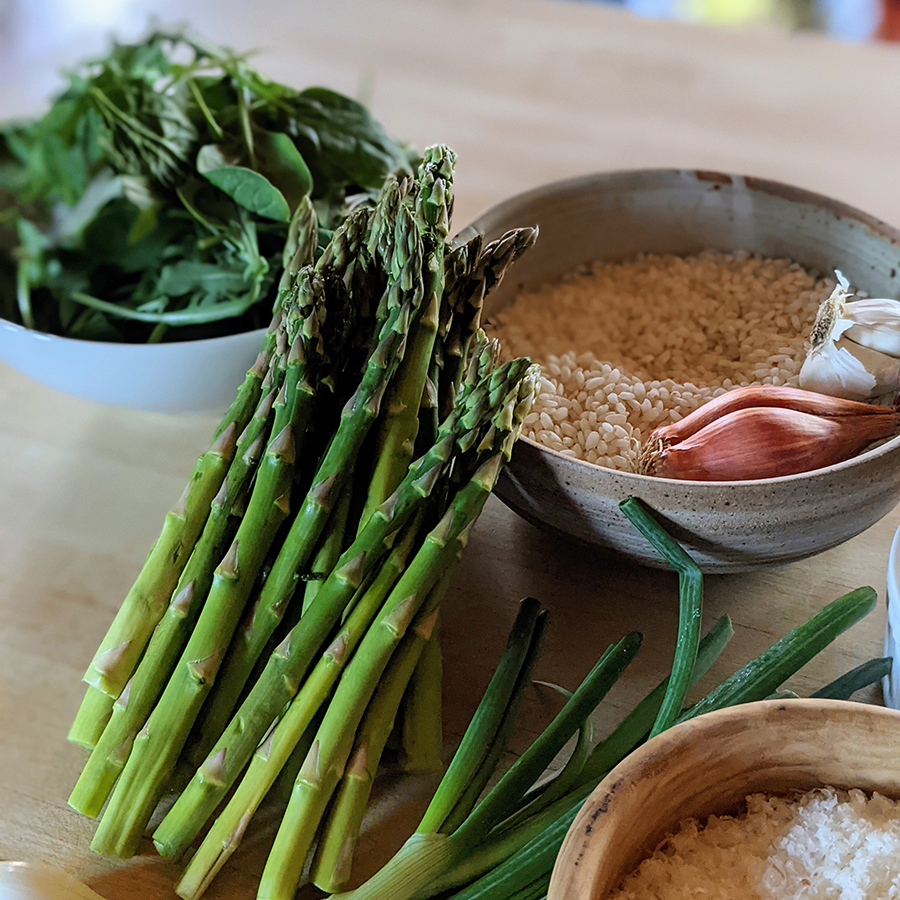
There are a couple of other tips I want to share. In the ingredient list, you’ll notice the recipe calls for 1 cup of finely grated Parmesan. This is parmesan that is grated with a microplane, which creates a light and fluffy pile of cheese. If you use a box grater or use parmesan that has been freshly grated in the store you could reduce this amount to ¾ c. There is also a very special ingredient I like to add right at the end: fresh whipped cream. This adds a creamy, velvety, and airy texture that takes this to the next level of deliciousness. You could serve the risotto in bowls which are totally fine or if you want to eat it like the Italians do, spread it out on a warm flat plate, garnish with parmesan and chives and serve immediately.
Ingredients
8 c. vegetable broth
3 T. butter
1 large shallot, minced
2 cloves of garlic, thinly sliced
2 c. carnaroli (or arborio) rice
½ c. dry white wine
1 c. peas
1 bunch of asparagus, trimmed and cut into 1” pieces
4 c. fresh arugula
1 c. finely grated parmesan, plus more for grating
½ c. heavy cream whipped to stiff peaks and kept in the fridge
¼ c. minced chives, for garnish
Method
Bring vegetable broth to a simmer in a medium saucepan. In a large heavy-bottomed pot, melt butter over medium heat. Add shallot, a pinch of salt, and stir with a wooden spoon. Cook on low for a few minutes until the shallot begins to soften. Add the garlic and cook another minute or two more.
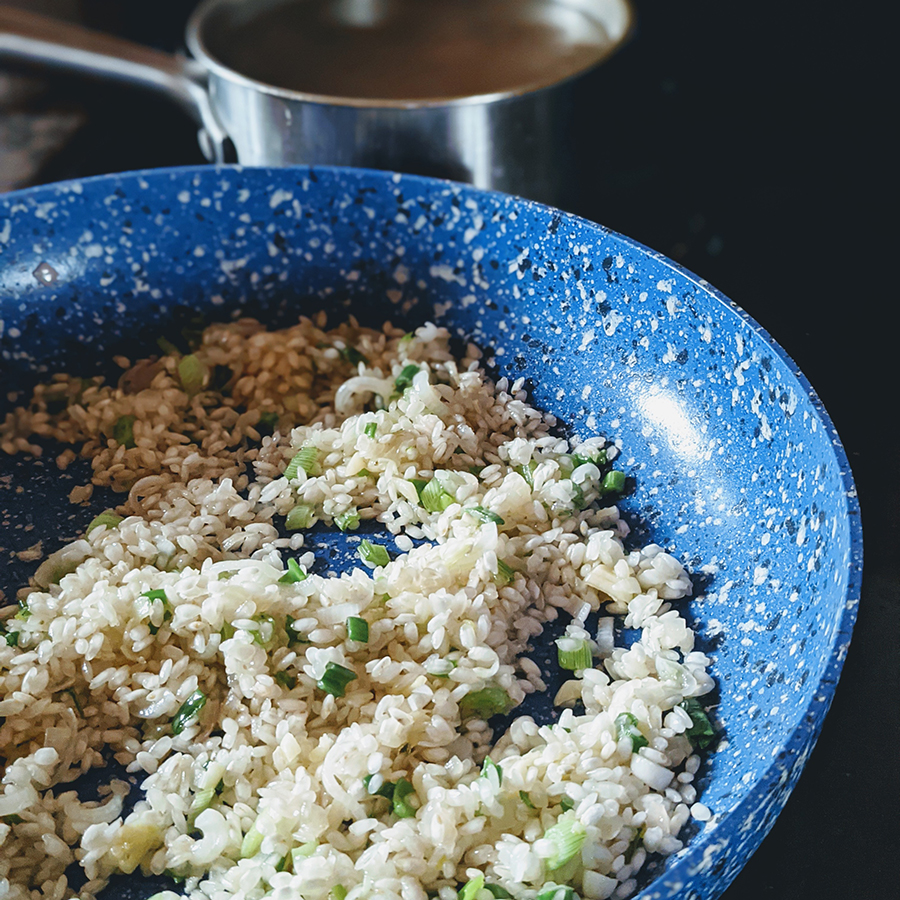
Add the rice and stir for a few minutes. This is called toasting the rice, even though you’re not getting any toasty color on it. It’s a super important step because this creates a protective shield around each grain which controls the amount of starch that is released during cooking and also prevents it from absorbing liquid too quickly during cooking. Once you can hear the rice start to crackle, It’s time to deglaze!
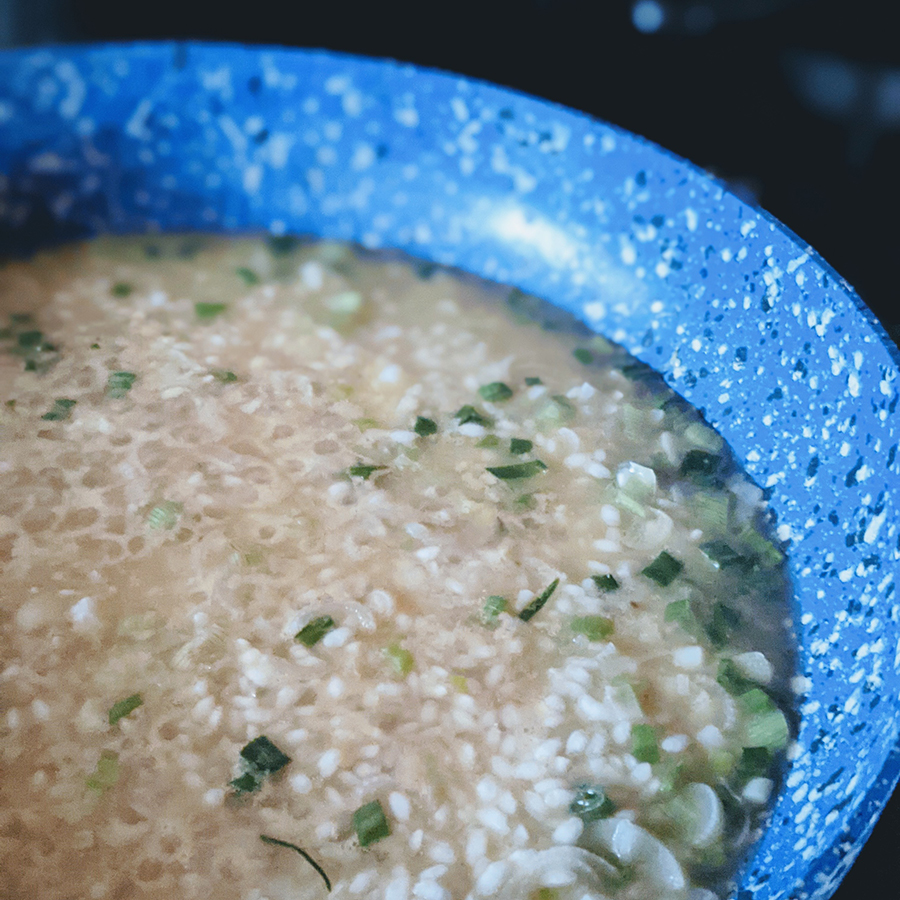
Pour the white wine into the pan and stir, scraping off any bits stuck to the bottom of the pan. Continue to cook until the wine has almost evaporated (a few minutes). Add around a cup of hot broth at a time, waiting to add more until the rice absorbs it. Along the way, taste the rice. It’s done when it tastes tender with a bite (al dente). It should take around 20 minutes of stirring, adding broth, and tasting. I recommend sipping on your favorite beverage while you stir.
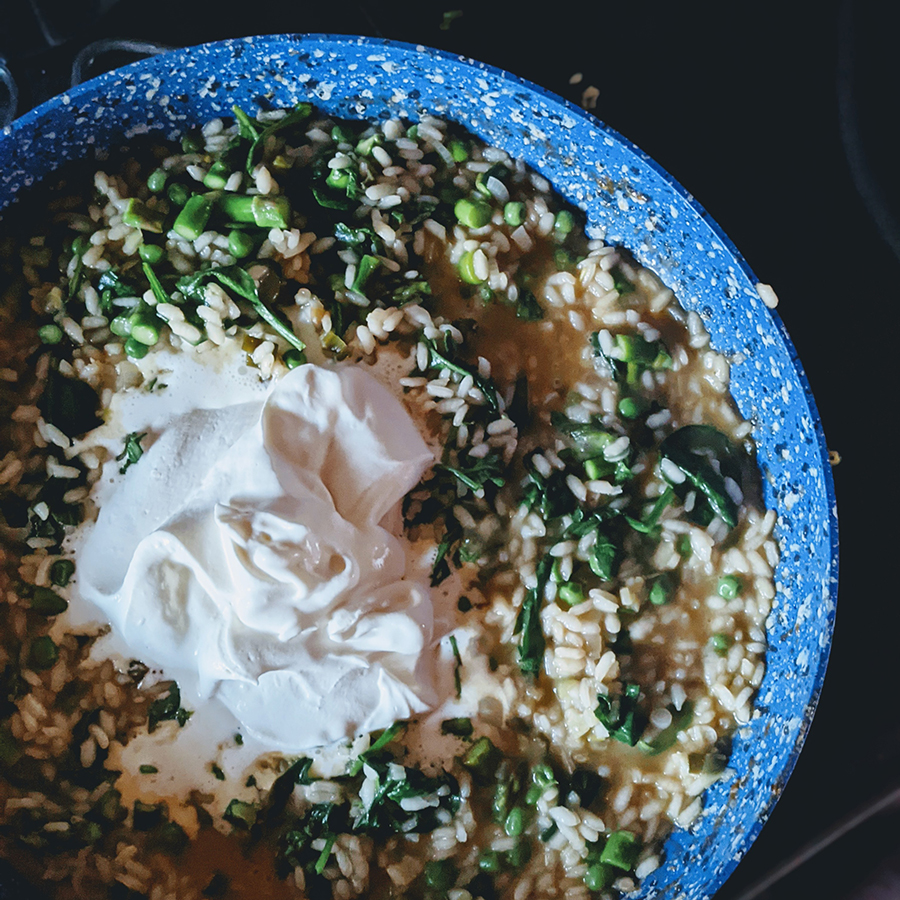
Right before the rice reaches the al dente perfect texture, add the peas, asparagus and cook for a couple of minutes. Add the arugula and stir until it wilts into the pot. Now you’re ready to finish and serve.
I like to call everyone to the table at this point. I add the cheese and stir that in for a minute. I season it with salt and pepper and I give it a taste. Now fold in the whipped cream. Don’t stir it vigorously or the air will dissipate. This adds a luxurious light and airy texture. Taste again and add salt and/or pepper as needed. Spoon into bowls or spread on a large flat plate. Garnish with cheese and chives, and most importantly, eat it while it’s hot.
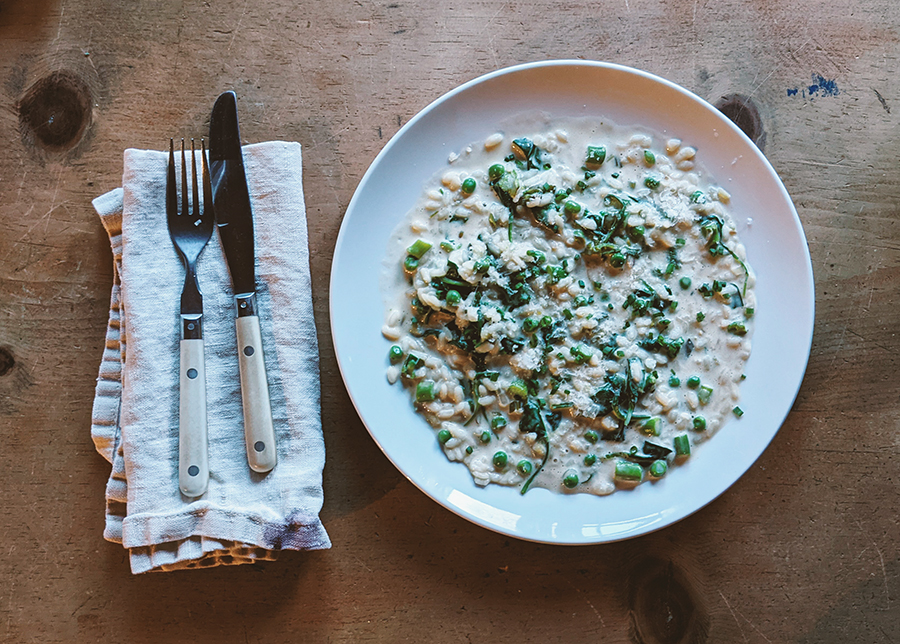
Rhubarb, Lavender & Red Chile Crisp
Time: 1.25 hours
Yield: Serves 6
Aside from the perfectly ripe nectarine or plum, my favorite fruit for any baked good is rhubarb. It’s naturally tart and easily transitions into a perfect combination of sweet & sour with the addition of something sweet, in this case, brown sugar. If the idea of rhubarb on its own is too pucker-inducing for you, feel free to add strawberries, blueberries, apricots, or a sweet apple variety to mix it up.
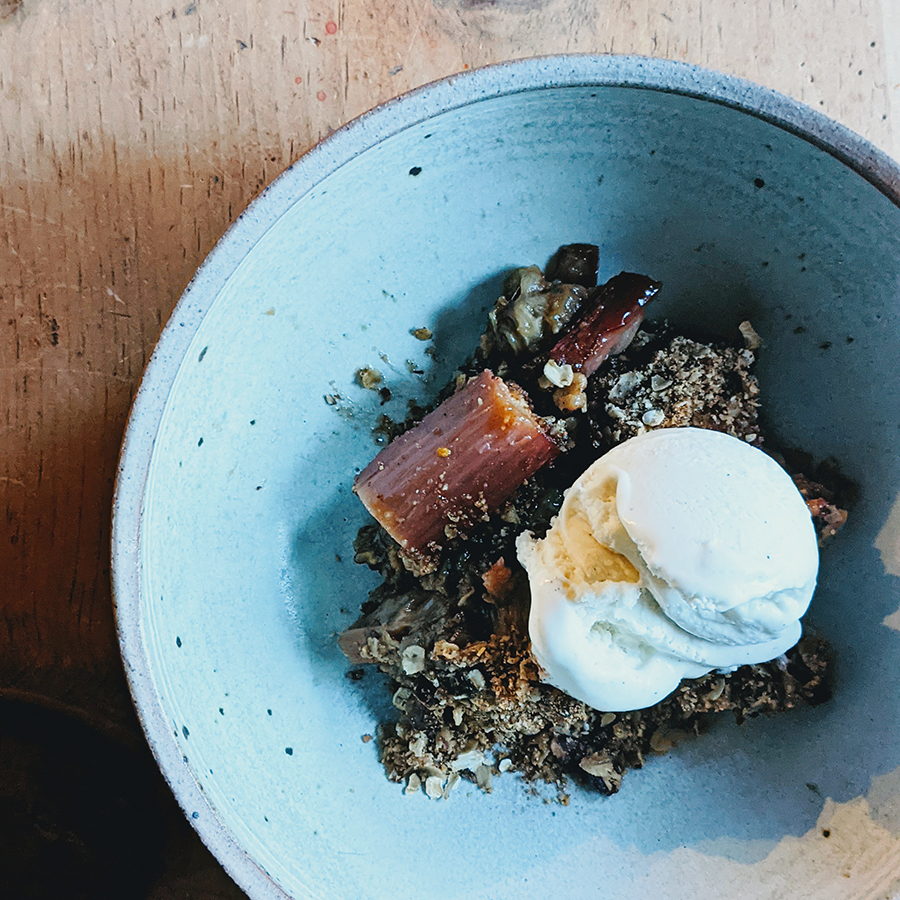
There are a handful of flavors that go exceptionally well with rhubarb, so I would encourage you to think about what sounds exciting to you. Flavors like lemon, black pepper, ginger, rose, coconut, cardamom, cinnamon, caramel are some of the first that pop to mind. In this version, I love bringing in elements of the Southwest in the form of lavender and red chile powder to the crisp topping. The floral notes from the lavender and the slight heat from the chile bounce off the bright fruit that has mellowed and melted into a decadent, slightly caramelized saucy delight.
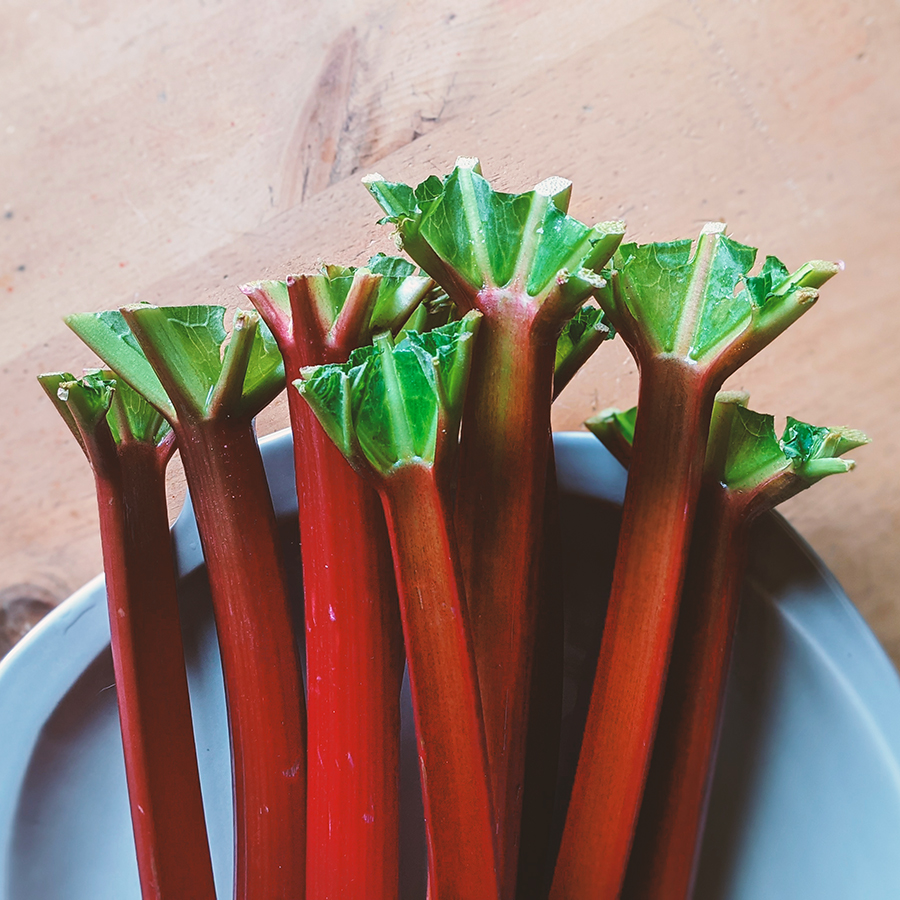
Because the window for growing rhubarb outdoors is short, when I see it at the grocery store or the market it’s hard for me to pass up. It’s a fruit celebration of early spring and a reminder of the bounty of summer fruits ahead when rhubarb days will be a distant memory. When I make this at home we usually have it for dessert the first night with vanilla ice cream or fresh whipped cream. As if that is not wonderful enough, the next morning we pull the leftovers out of the fridge and have it for breakfast with a spoon of greek yogurt and a drizzle of raw honey. I still can’t decide which is my favorite.
Ingredients
For the filling:
1 T. butter
2# rhubarb, cut into 2” pieces
½ c. brown sugar
1 orange, zested
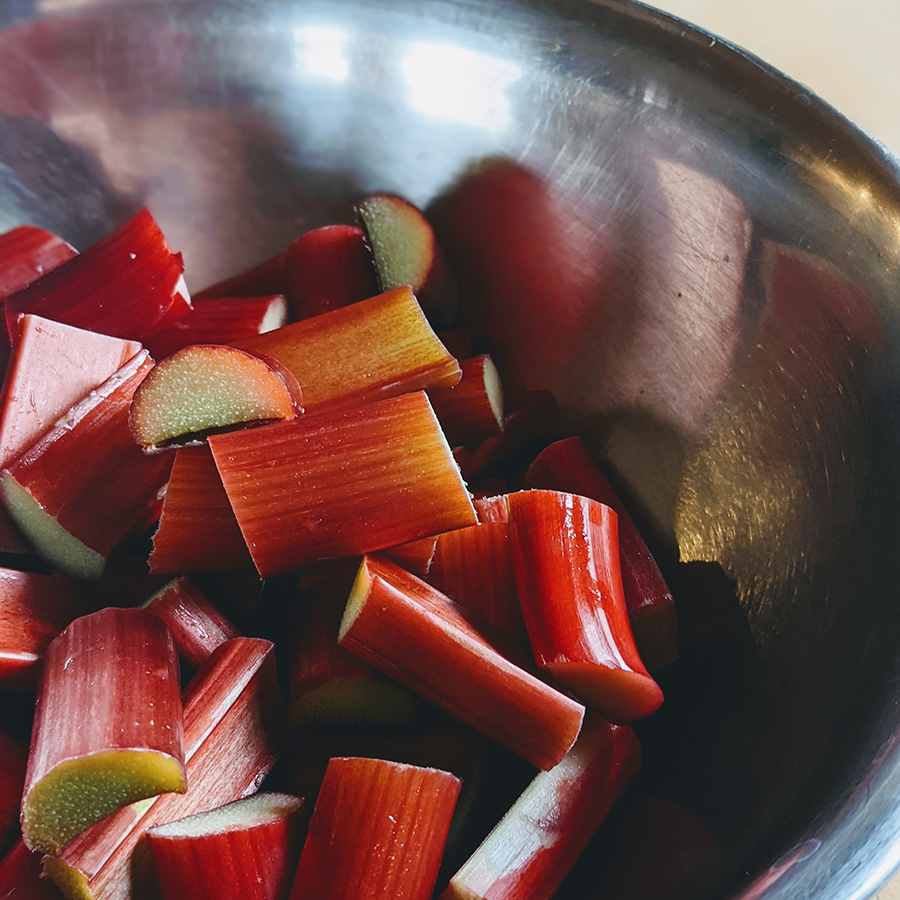
for the crisp:
1 c. flour of your choice (All-Purpose, whole-wheat, coconut flour, or almond flour)
2 t. ground cinnamon
2 t. New Mexico mild or medium red chile powder
2 t. ground dried culinary lavender
1 c. brown sugar
1 c. rolled oats
½ c. almond or pecan pieces
½ c. melted butter
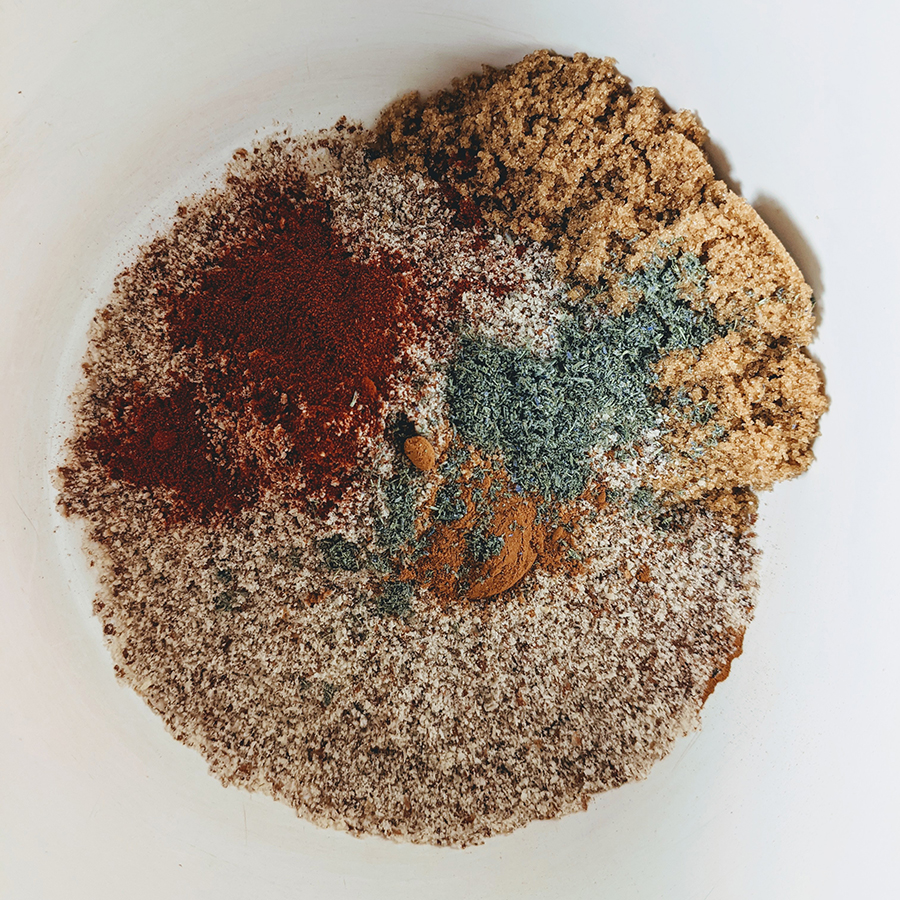
Method
Preheat the oven to 375 F. Butter a 9-10” baking dish, cast iron, or another oven-safe skillet.
In a large bowl mix together the rhubarb, brown sugar, and orange zest. Transfer this mixture to your buttered pan.
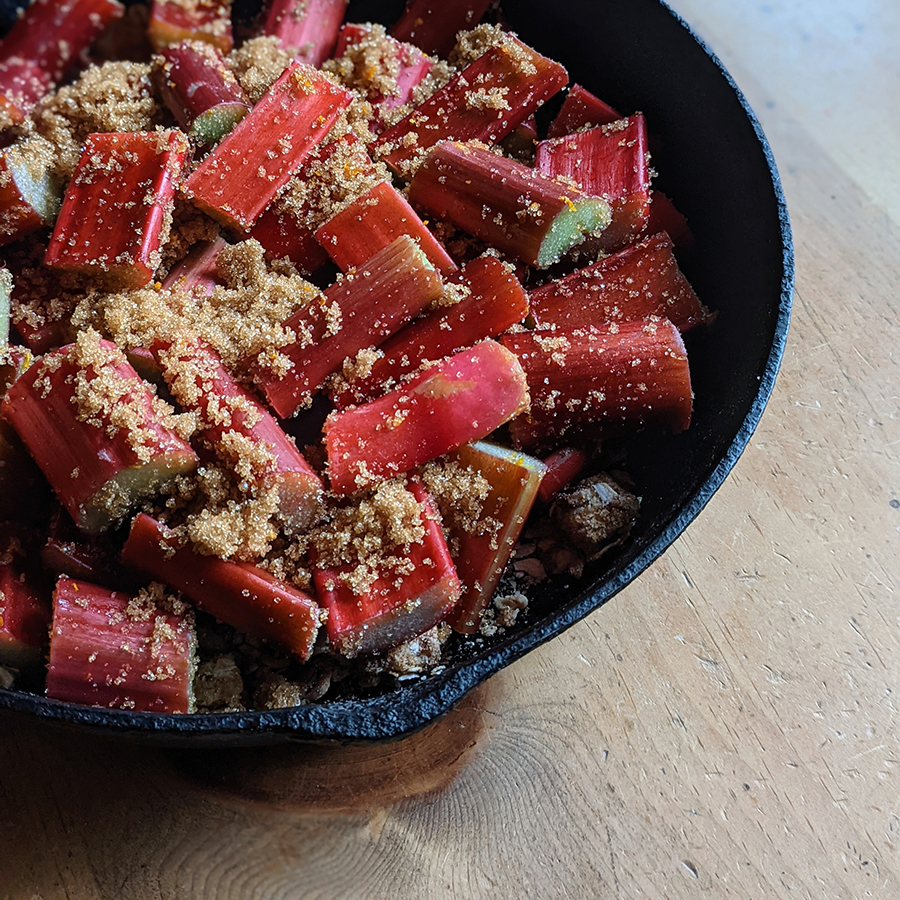
With your hands or a wooden spoon, stir together the flour, cinnamon, red chile powder, lavender, brown sugar, oats, nuts, and melted butter. With your hands, crumble this evenly over the top of the fruit.
Bake the crisp for around 50 minutes or until the fruit is bubbling and the top is golden brown. Let it cool for ten minutes before spooning it into bowls and serving.
